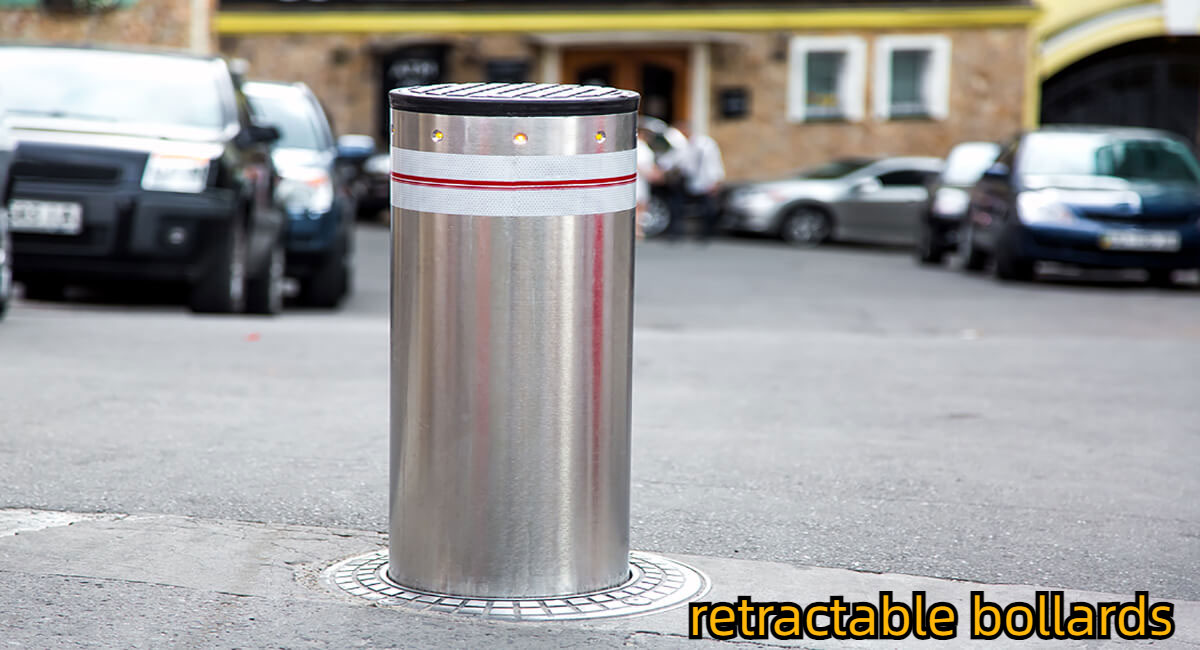Security and traffic control are ever-changing needs and retractable bollards have become a versatile and efficient solution. These convenient vehicle barriers can be raised or lowered to the ground, providing a way to control vehicle traffic while allowing unobstructed pedestrian access. Thanks to their telescopic mechanism, they offer greater flexibility and convenience compared to their fixed and movable counterparts.
In today’s guide, we’ll take a look at retractable bollards. Includes definitions, benefits, types, and how to choose. Read on to learn more.
1. What are retractable bollards?
Retractable bollards, also known as telescoping bollards or rising bollards, are vertical vehicle safety barriers that can be extended above the ground or lowered below the ground. They offer more flexibility than permanently installed fixed bollards and are more convenient than removable bollards.
The adjustability of telescopic bollards makes them an effective solution for controlling vehicle traffic while maintaining pedestrian mobility at all times. This versatility makes retractable bollards increasingly common in residential, public, and commercial spaces.
Retractable bollards are ideal for temporarily closing access roads, restricting traffic to pedestrians on the street, or even preserving parking spaces. They are also an effective solution for protecting sensitive or hazardous areas from ramming vehicle intrusion. In this case, their role is to limit or prevent them from speeding up.
In short, they meet a large number of applications in cities, company parking lots, shopping malls, tourist and hotel complexes, collective housing, etc.

2. How do retractable bollards work?
Retractable bollards are installed deep underground into an underground shell that allows the main column to retract into it. The bollards will be flush with the ground, reducing tripping hazards, rather than leaving posts or caps on the ground.
Manual and semi-automatic bollards usually don’t require anything else after installation. However, automatic bollards must be wired and programmed at the time of installation. These bollards can be accessed through a control panel usually located near the access point.
Automatic telescopic bollards can be operated via Bluetooth app, license plate recognition, remote control, or time and date programming.
Use: Retractable bollards are used to prevent vehicles from entering an area or to prevent vehicles from being stolen while in place. While retractable bollards require more labor when installed, their long-term benefits more than makeup for it. Because retractable bollards are installed in underground concrete, they offer excellent durability over time. They are difficult to remove from their original location, providing excellent access control when needed.

3. Types of retractable bollards
The following are types of retractable bollards typically installed in medium to high-security facilities such as corporate campuses, public event spaces, and government buildings:
1) Divided according to power system
The following is divided according to the internal power system of the bollard.
#1. Hydraulic bollards
Retractable hydraulic bollard systems use a fluid, generator, and pump system. Fluid expands in and out of the system and pushes the air compression motor cylinder. This type of operation is generally the fastest, with the system booting in just a few seconds.
#2. Electric bollards
Retractable electric bollard systems are powered by an electric motor that operates a cylinder piston to raise or lower the bollard. This type of operation has the most consistent speed and is generally quieter when activated.
#3. Pneumatic
Retractable pneumatic bollard systems use compressed air to operate a cylinder piston to raise or lower the bollard. This type of operation is the simplest, and cheapest, and generally requires less maintenance over time.
2) Divide according to control type
Retractable bollards range from simple manual designs to more complex automated systems. While their operation may vary depending on the specific type, all retractable bollards share the same basic principles. They can be retracted or extended as needed, allowing authorized vehicles to pass unimpeded.
#1. Manual Telescopic Bollards
Manual retractable bollards are the simplest form of retractable bollards. They require physical strength to lift it from the socket or lower it to the ground. A built-in locking mechanism ensures the bollard remains in the upright or down position, preventing post-tampering.
Due to the manual operation required, manual rising bollards are typically used in environments where authorized vehicles rarely require access. For example, they can be used to cordon off pedestrian areas in city centers, allowing occasional access for construction or service vehicles.
#2. Semi-automatic bollards
Semi-automatic bollards or lift-assisted bollards work similarly to manual bollards. However, they are made with a pneumatic spring mechanism that reduces operating weight and helps users lift rising bollards more easily.
This can make them a more user-friendly option, especially for locations that require more frequent access to changes. They still require manual entry, but the process is less physically demanding and time-consuming.
#3. Automatic bollards
Automatic rising bollards, also known as electric bollards or automatic telescopic bollards, offer the highest level of convenience and functionality. Thanks to internal hydraulic or pneumatic mechanisms, they can be raised or lowered at the push of a button, eliminating the need to manually lift the bollards. They are wired and connected to a control system, allowing the bollards to be operated remotely via a keypad, key fob, or similar device.
Automated bollard systems are particularly useful in high-traffic areas such as public parking lots. They are generally more expensive than manual and semi-automatic models but are ideal for environments where access needs change frequently.

4. What are the benefits of installing retractable bollards?
Installing retractable bollards has many benefits for security and perimeter protection. Here are 6 advantages that make it a great solution.
1) Safety
When the correct bollards are selected and configured with the help of physical security engineers and designers, bollards can provide reliable protection for pedestrians and buildings. When installed correctly by experienced certified installers, retractable bollards can safely protect pedestrians and spaces where buildings are at risk of being struck by vehicles. These spaces may include striking buildings, busy downtown streets, sidewalks, walkways, bike lanes, crosswalks, and more.
2) Aesthetics
Some early models of retractable bollards were not designed with the visual appeal that architects were looking for. Over the years, many telescoping bollard manufacturers have made improvements in surface finish and architectural details. This enhances the beauty and visual impact of the surrounding landscape.
3) Versatility
Perhaps the greatest benefit of installing retractable bollards is the versatility of retractable bollards to prevent or allow vehicles to enter an area while still allowing pedestrian traffic. Whether it’s a delivery zone, emergency driveway, or restricted access area, by raising bollards you can block vehicle traffic, while folding bollards allow full access.
4) Durability
Retractable bollards can last for many years and are an extremely reliable solution when maintained regularly by a professionally trained team. There are many excellent bollard manufacturers that have been around for decades and make durability a top priority. When you install high-quality retractable bollards, it becomes a long-term solution for the facility.
5) Convenience
Retractable bollards are convenient for several reasons, but the biggest reason is the ability to control the operation of the bollard via a touch screen, remote control, or operator panel. There is no need to manually remove the bollards every time you need to access the area, which makes retractable bollards superior to removable bollards.
6) Variety
Manual, semi-automatic, and automatic bollards are available in a variety of sizes, materials, colors, and finishes, allowing designers to choose the ideal model based on their needs and budget.

5. Factors to consider when installing retractable bollards
Here are factors to consider when selecting and installing retractable bollards.
1) Installation location
First, you must know what the terminal is used for and where it is installed. For example, you want to equip: Pedestrian areas, markets, military sites, parking lots, residences, etc.
2) Climate
For example, for installations in mountainous areas or areas with negative temperatures, terminals are often equipped with heating solutions to protect against cold and frost. For installations on the coast, the terminals will be equipped with anti-corrosion stainless steel coatings to protect them from wet and salty environments.
3) Environment
Consider the background surrounding the installation location. For example, if the bollards are located in a pedestrian area and there is heavy traffic during certain times of the year, then the chosen solution will have greater consideration for pedestrian and cyclist safety.
4) Types of vehicles that will cross the channel
In situations where heavy and large vehicles pass, such as in storage premises, we would rather recommend a high-resistance bollard solution with a height of 600 to 800 mm so that the unit can bear the weight of the vehicle over the long term and prevent the bollard from suffering in the event of an impact damaged severely.
5) Frequency of use
You must then determine the frequency of use so that the selected terminal is efficient enough relative to the number of ascents/descents required. The selection will differ depending on whether the terminal is used rarely or frequently.

6. FAQ
Here are answers to frequently asked questions about retractable bollards.
1) Are retractable bollards anti-collision?
The Department of State, Department of Defense, and ASTM certify several types of vehicle guardrails, including retractable bollards. Certified vehicle guardrails are “crash-proof,” meaning they have been subjected to full-field crash testing using real vehicles. These tests verify their ability to stop vehicles at certain speeds and specific vehicle weights. Crash-resistant retractable bollards are reviewed annually by the Army Corps of Engineers and the Department of Defense to publish the latest DoD list of crash-resistant vehicle barriers each year.
The most common crash rating standards for telescoping bollards are ASTM F2656-07 and ASTM F3016-14. These standards dictate how top bollard manufacturers should crash-test their products to verify their ability to stop striking vehicles. ASTM F2656-07 is the standard test for most vehicle guardrails. ASTM F3016-14 is designed to test vehicles with crash speeds of 30 mph or less.
2) Why use retractable bollards?
- High level of safety against vehicle impacts: Retractable columns must be installed deep underground so that they can be retracted. This provides a solid foundation with excellent resistance to vehicle impact.
- Easy to use: Folding bollards simply raise or lower when needed. Manual bollards need to be lifted into place, while automatic bollards can be raised or lowered on their own or via remote control.
- Reduced Trip Hazards: Retractable posts will sink completely into the ground, reducing trip hazards on the ground. With most bollards, the top cap sits flush with the surface when retracted, unlike removable or folding options that can leave a tripping hazard.
3) What is the PAS68 grade?
The PAS68 rating refers to an impact resistance test used to determine the strength of a bollard or barrier and its suitability for hostile vehicle mitigation (HMV). How much force can foldable bollards withstand? Retractable bollards are often used for anti-collision purposes, and some are suitable for anti-terrorism protection on public streets and government buildings.
4) How much force can the retractable bollards withstand?
Depending on the type of bollard, it may be able to withstand a certain amount of force. This will depend on:
- Impact vehicle speed
- Bollard size and thickness
- The angle of being hit
- General wear and tear has affected the bollards
Most uprights cannot withstand the impact of a vehicle. However, some versions may stop hitting vehicles at lower speeds. When purchasing uprights, check for ratings including PAS68 or Hostile Vehicle Mitigation (HVM) as mentioned in the specification.
5) How long does it take to retract the bollards?
Manual retractable bollards can be lowered or raised as quickly as possible. Our automatic retractable bollards can be raised or lowered in approximately 7 – 8 seconds.

7. Conclusion
With the advancements manufacturers have made over the past decade, retractable bollards have made huge strides in performance and aesthetics. It has become an increasingly ideal solution for many facilities, such as corporate campuses, stadiums, public event spaces, and government buildings. If you have questions about telescoping bollards or need help with design or maintenance, contact Aotons.





Leave A Comment